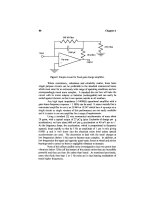Passive Sampling Techniques Episode 6 docx
Bạn đang xem bản rút gọn của tài liệu. Xem và tải ngay bản đầy đủ của tài liệu tại đây (144.8 KB, 5 trang )
Replacing water by air as intermediate phase resulted in an increase in
sampling rates up to a factor of 6. Decreasing sampling rates were ob-
served for the 5-ring PAHs, which showed a decrease in sampling rate
by a factor of 2–3 as a result of their very low K
aw
values (o3 Â 10
À5
).
The use of 1-octanol as intermediate phase resulted in an approximately
20-fold increase in sampling rates compared with water as intermediate
phase [5]. It should be noted again, however, that reducing the transfer
resistances of the internal phases, enhances the relative importance of
the mass-transfer resistance of the WBL (Eq. (7.5)), and hence the sen-
sitivity of the sampler to changes in flow conditions.
7.9 CALIBRATION
7.9.1 Static exposure design
In the experimentally convenient static exposure scenario, passive
samplers are exposed in a single volume of contaminated water. This
method has been used in the past for determining bioaccumulation
factors and uptake rates of contaminants by fish and mussels. The
evolution of aqueous concentrations in the exposure water is given by
[58–60]
C
w
¼
C
w0
1 þ
K
sw
V
s
V
w
exp À 1 þ
K
sw
V
s
V
w
R
s
t
K
sw
V
s
1 þ
K
sw
V
s
V
w
(7.38)
where C
w0
is the aqueous co ncentr ation a t t ¼ 0. The concentration in the
sampler can be evaluated from the mass balance (V
s
C
s
¼ V
w
[C
w0
– C
w
])
C
s
¼
C
w0
K
sw
1 À exp À 1 þ
K
sw
V
s
V
w
R
s
t
K
sw
V
s
1 þ
K
sw
V
s
V
w
(7.39)
which reduces to Eq. (7.12) in the limit V
w
-N. With Eqs. (7.38) and
(7.39) it is assumed that there are no c ompeting sorption phases (e quip-
ment and pa rticula te/d issolve d or ganic mat ter ) in t he e xposu re sys tem. I n
the short time limit, Eq. ( 7.38) ma y b e a pproximate d b y
C
w
¼ C
w0
1 À
R
s
t
V
w
þÁÁÁ
(7.40)
K. Booij , B. Vrana and J.N. Huckins
158
Chapter 8
Tool for monitoring hydrophilic
contaminants in water: polar organic
chemical integrative sampler
(POCIS)
$
David A. Alvarez, James N. Huckins, Jimmie D. Petty,
Tammy Jones-Lepp, Frank Stuer-Lauridsen, Dominic
T. Getting, Jon P. Goddard and Anthony Gravell
8.1 INTRODUCTION
Global emissions of persistent bioconcentratable organic chemicals
have resulted in a wide range of adverse ecological effects. Conse-
quently, industry developed less persistent, more water soluble polar or
hydrophilic organic compounds (HpOCs), which generally have low
bioconcentration factors. However, evidence is growing that the large
fluxes of these seemingly more environmentally friendly compounds
(e.g., pesticides, prescription and non-prescription drugs, personal
care and common consumer products, industrial and domestic-use
chemicals, and their degradation products) into aquatic systems on a
world-wide basis may be responsible for incidents of acute toxicity and
sublethal chronic abnormalities [1–3]. These adverse effects include
altered behavior, neurotoxicity, and severely impaired reproduction [4].
Furthermore, the presence of these HpOCs likely plays a major role in
the endocrine disrupting effects of complex mixtures of chemicals
present in aquatic environments [5,6]. In regard to physiological
effects, pharmaceuticals are of particular concern because they are
designed to elicit diverse pharmacological responses. Unfortunately,
$
Although the research described in this chapter has been funded in part by the United States
Environmental Protection Agency through (IAG #DW14900401) to USGS-CERC, it has not been
subjected to Agency review and, therefore, does not necessarily reflect the views of the Agency and
no official endorsement should be inferred.
Comprehensive Analytical Chemistry 48
R. Greenwood, G. Mills and B. Vrana (Editors)
Volume 48 ISSN: 0166-526X DOI: 10.1016/S0166-526X(06)48008-9
r 2007 Elsevier B.V. All rights reserved.
171
TABLE 8.1
Classes or specific chemicals known to concentrate in POCIS
23 pharmaceuticals including
Acetaminophen
Azithromycin
Carbamazepine
Propranolol
Sulfa drugs (antibiotics)
Tetracycline antibiotics
2 illicit drugs (methamphetamine, MDMA)
Several natural and synthetic hormones
17b-Estradiol
17a-Ethynylestrad iol
Estrone
Estriol
12 Triazine herbicides including
Atrazine
Cyanazine
Hydroxyatrazine
Terbuthylazine
Various polar pesticides including
Alachlor
Chlorpyrifos
Diazinon
Dichlorvos
Diuron
Isoproturon
Metolachlor
Various household and industrial products and degradation products
including
Alkyl phenols (nonylphenol)
Benzophenone
Caffeine
DEET
Indole
Triclosan
Urobilin (fecal contamination marker)
Essentially, any compound with log K
ow
r3.0
Polar organic chemical integrative sampler (POCIS)
177
TABLE 8.5
Pharmaceutical compounds in the effluent of British WWTPs
Chemical Matrix %
recovery
Site 1
a
Site 2 Site 3
Survey 2 Survey 3 Survey 1 Survey 2 Survey 3 Survey 1 Survey 2 Survey 3
Acetaminophen 98 (2.5)
b
o0.005 o0.005 o0.005 o0.005 o0.005 o0.005 o0.005 o0.005
Dextropropoxyphene 90 (2.3) 0.50 (6.9) 0.59 (22) 0.47 (26) 0.32 (15) 0.32 (3.3) 0.72 (10) 0.62 (12) 0.89 (9.3)
Diclofenac 95 (2.5) 0.48 (20) 0.41 (26) 2.0 (9.0) 0.82 (49) 1.8 (94) 2.9 (6.4) 1.9 (24) 0.61 (5.1)
Erythromycin 130 (18) 0.15
c
0.15
c
o0.005
c
o0.005
c
0.033
c
0.10
c
0.064
c
o0.005
c
Ibuprofen 99 (5.3) o0.005 o0.005 o0.005 o0.005 o0.005 o0.005 o0.005 o0.005
Mefenamic acid 97 (7.4) o0.005 o0.005 o0.005 o0.005 o0.005 o0.005 o0.005 o0.005
Propranolol 95 (2.2) 0.36 (3.8) 0.41 (20) 0.68 (36) 0.62 (14) 0.74 (2.0) 1.1 (7.1) 1.0 (2.5) 1.3 (7.3)
Sulfamethoxazole 95 (4.3) o0.015 o0.015 0.17 (13) 0.16 (61) 0.19 (17) o0.015 o0.015 o0.015
Tamoxifen 93 (0.8) o0.005 o0.005 o0.005 o0.005 o0.005 o0.005 o0.005 o0.005
Trimethoprim 95 (2.8) 0.28 (7.7) 0.06 (10) 0.05 (59) 0.08 (26) 0.11 (10) 1.0 (5.1) 0.75 (7.5) 0.80 (8.0)
Recovery of targeted analytes from fortified matrix and concentrations in POCIS (pharmaceutical configuration) samples from each site are given.
Results are presented at micrograms of chemical sequestered per POCIS. CVs are given in parenthesis (n ¼ 3).
a
Survey 1 POCIS from Site 1 were lost during deployment.
b
Acetaminophen recovery from the fortified POCIS matrix performed at n ¼ 2.
c
Only one replicate from each survey was analyzed.
D.A. Alvarez et al.
190
Fig. 8.5. Selected LC–MS extracted ion chromatograms for trimethoprim, propranolol and dextropropoxyphene in a
POCIS extract from Site 3, Survey 2 (Replicate B) of the pharmaceutical reconnaissance in British WWTP effluents.
191
Polar organic chemical integrative sampler (POCIS)









